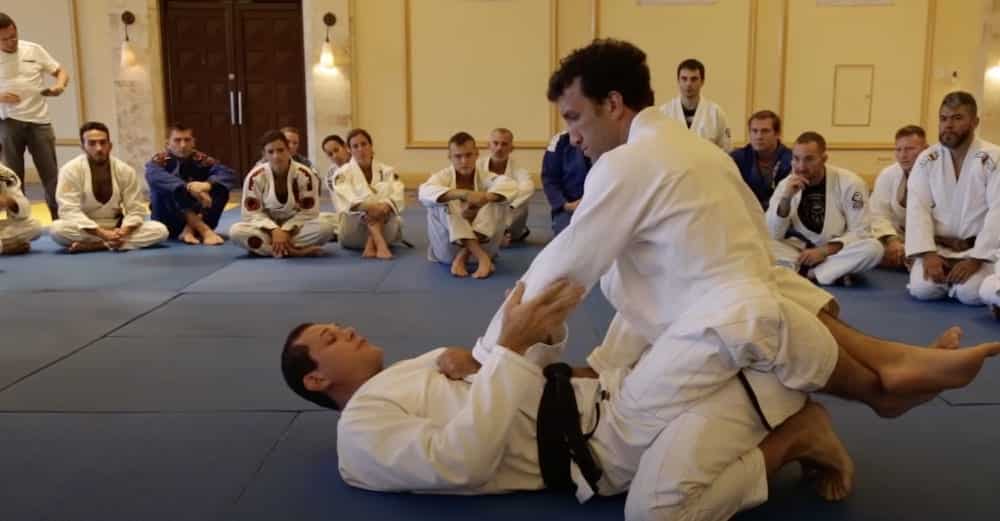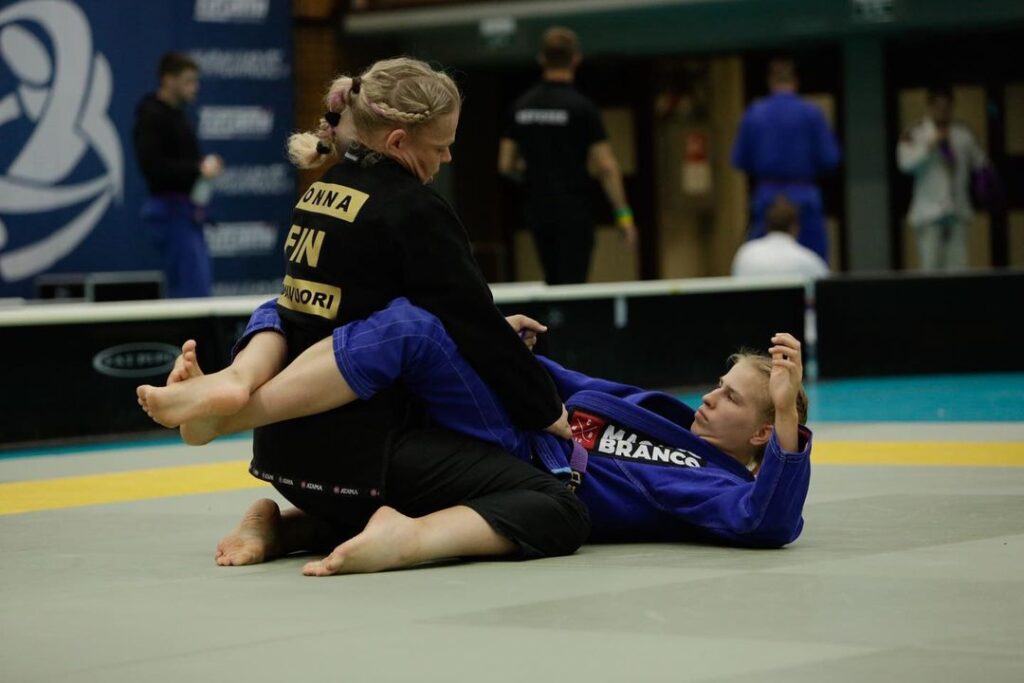Closed Guard – BJJ Technique Explained

Whenever you start out learning BJJ, the very first guard you begin learning is the closed guard. From closed guard, you are able to understand how to do basic sweeps and submissions.
The closed guard may seem basic, but you can develop a very effective game built around it. Just like legendary grappler Roger Gracie, who specializes in closed guard.
Let’s go a little old school and tell you everything you need to know about closed guard. We’ll detail how it was created, how it works, and detail numerous techniques from this position.

Contents
Who Came Up With The Closed Guard?
A guard has been used in countless styles of grappling like Judo and early Japanese Jiu Jitsu before BJJ was created. But the closed guard was innovated within Brazilian Jiu Jitsu.
At first, the Gracie family began using a closed guard for numerous reasons. The two biggest being for self defense against a bigger person and being able to keep your opponent close.
Years later, the closed guard really started to be innovated by two of Master Osvaldo Alves’ students. Sergio Pena and Pascal Magalhães.
Pena and Magalhãe became two of the most dominant Jiu Jiu Jitsu competitors of the era. Submitting names like Sylvio Behring and Royce Gracie all from the closed guard.
These two would create numerous setups from the closed guard to land triangles, armbars, and sweeps. Even though closed guard has fallen out of fashion it is still taught as a fundamental position.
How does the closed guard work?
The closed guard works for you to fight off your back, while keeping your opponent close. When you lock your legs around your opponent’s waist it limits the space between you and them. Putting you at an offensive advantage over your opponent, who must make space and escape.
With the space limited between you and your opponent in theory it makes it easier to do sweeps and submissions. You can sit up to break their posture and go into whatever technique you want.
2 on 1 Scissor Sweep
A traditional scissor sweep has you grab the collar and your opponent’s arm. For this variation of the scissor sweep, we grab their arms with both hands.
Start by cross grabbing your opponent’s sleeve. From closed guard this grip is easy to get due to your opponent trying to set their grips to pass.
With your free arm grab right at your opponent’s triceps. When you have these two grips together it makes it really hard for them to posture.
Next pivot your hips out and put your knee on your opponent’s shoulder and the other on theirs. Start kicking behind their shoulder to push them to the side. Then take your other foot off their hip and kick it through their body to complete the sweep.
Hip Bump Sweep
The hip bump sweep is one of the first sweeps you learn from the closed guard and is very easy. Your first step is to sit up and break your opponent’s posture.
Instinctively, they will posture up and that is when you go into your hip bump sweep. Open your guard, put your feet on the mat, then sit up, and hook over your opponent’s elbow.
Now to sweep them over, drive your hip into their chest with force to take them over to complete the sweep.
Closed Guard Sweep
This is really a closed guard sweep, because your guard never opens during the sweep. It comes off when your opponent stands up in your guard to pass.
You can reach their head to break their posture, so you have this sweep option. Cross grab their sleeve and underhook their same side leg.
Then look to the side and turn your hips over the leg you have an underhook on. As soon as they turn their foot, bring your underhook to your head to sweep your opponent to their back.
When they fall, keep your sleeve grip for control and walk yourself into the mount.
Flower Sweep
The flower sweep famously used by world champion Xande Ribeiro is a great sweep from closed guard. It takes little to know strength to take your opponent over for the sweep.
First take a sleeve grip and pin the opponent’s arm to your chest. Next grab your opponent’s pants right above their ankle, where there is more loose material.
Then open your guard and step your foot. At the same time your other leg in their armpit and use your pant grip to bring their leg up.
Doing these motions together makes it really easy to sweep your opponent over into the mount.
Triangle From Closed Guard
One of the most used submissions from the closed guard is the triangle choke. This is because it is easier to break your opponent down and set it up.
Start breaking your opponent’s posture and controlling their head with one arm. Keep your elbow in to block your opponent from swimming their arm in and defending.
Next take a deep overhook on your opponent’s other arm. This will be the arm that will be inside your triangle.
For the next step, open your guard and hip out to make space and bring your top leg on their back. The top leg goes on top of their back for control and to keep their posture broken.
Then you’re going to slide your hand down your opponent’s arm and takee wrist control. With their wrist controlled, push their arm and bring your leg through. Lifting your hips up, bringing your leg over their neck, and locking in your triangle.
Armbar From Closed Guard
This is the basic setup you use when learning how to do and armbar. Take wrist control and cross grab your opponent’s tricep. With these grips, pin your opponent’s arm to your chest to hold it in place.
Now before you bring your opponent’s arm over their hip, you have to control their head. With their head controlled, open your guard and put one foot on their hip and the other across their back.
To go for the finish, angle your hips out a little more and throw your leg over your opponent’s head. Make sure their thumb is up, you’re controlling above their elbow, and lift your hips for the finish.
Advanced Armbar From Closed Guard
It is good to learn the basic armbar setup from a closed guard. But when you get more experience, you’ll realize that it has a flaw.
It does not address that you need to keep your opponent’s posture broken in order to do an armbar. So here is an advanced setup that addresses that you need to break their posture and control their head.
Control your opponent’s elbow and hold their head. Then lift your hips and lock in a top lock over their elbow.
When you put this top lock, your opponent can’t move their arm. All you have to do is turn your hips and take the armbar.
Omoplata From Closed Guard
An omoplata from the closed guard starts by getting an overhook on your opponent’s arm. You can swim both arms in, putting their arms to the mat or sleeve gripping to get an underhook.
With their arm controlled, open your guard and hip out to bring your leg on top of your opponent’s back. At the same time you need to be framing your hand or arm on your opponent’s head.
To go into the omoplata, push their head away and bring your leg over their shoulder. Then to get in the finishing position, turn your hips and sit up.
When you sit up it is important to remember that you need to control their hips to keep them from defending. With their hips controlled, drive your hips into their shoulder to finish the omoplata.
Tips For Using The Closed Guard
The closed guard is the most fundamental and basic guard, but it does have important details you need to remember. Here are some tips when using the closed guard.
- Legs Locked: Make sure that your legs are locked around your opponent’s waist. Without doing this, you have an open guard and not a closed guard.
- Hands Ups: Always have your hands up to block and grab grips. It is also basic self defense to have your hands up to defend punches.
- Hips Off The Mat: When holding closed guard keep your hips off the mat and on top of your opponent’s legs. It makes it easier to move and makes your opponent hold more of your weight.
- Break Opponent’s Posture: For doing whatever technique from the closed guard, you have to first break your opponent’s posture.






